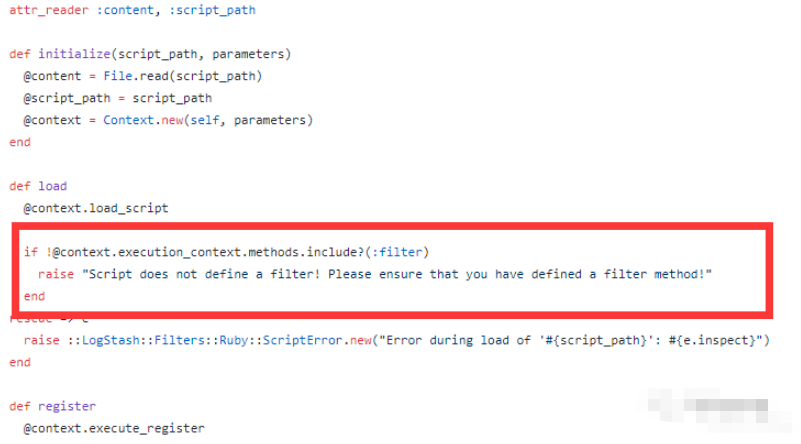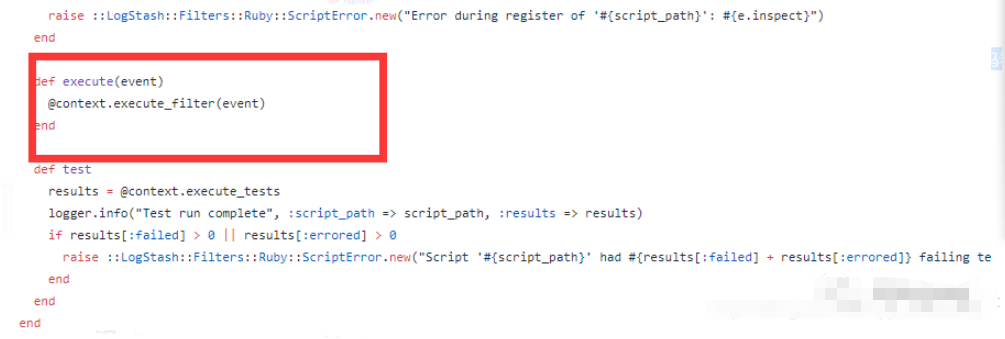жӮЁеҘҪпјҢзҷ»еҪ•еҗҺжүҚиғҪдёӢи®ўеҚ•е“ҰпјҒ
жӮЁеҘҪпјҢзҷ»еҪ•еҗҺжүҚиғҪдёӢи®ўеҚ•е“ҰпјҒ
д»ҠеӨ©е°Ҹзј–з»ҷеӨ§е®¶еҲҶдә«дёҖдёӢlogstashзҡ„rubyжЁЎеқ—жҖҺд№Ҳз”Ёзҡ„зӣёе…ізҹҘиҜҶзӮ№пјҢеҶ…е®№иҜҰз»ҶпјҢйҖ»иҫ‘жё…жҷ°пјҢзӣёдҝЎеӨ§йғЁеҲҶдәәйғҪиҝҳеӨӘдәҶи§Јиҝҷж–№йқўзҡ„зҹҘиҜҶпјҢжүҖд»ҘеҲҶдә«иҝҷзҜҮж–Үз« з»ҷеӨ§е®¶еҸӮиҖғдёҖдёӢпјҢеёҢжңӣеӨ§е®¶йҳ…иҜ»е®ҢиҝҷзҜҮж–Үз« еҗҺжңүжүҖ收иҺ·пјҢдёӢйқўжҲ‘们дёҖиө·жқҘдәҶи§ЈдёҖдёӢеҗ§гҖӮ


filter{#жү§иЎҢи§ЈжһҗйҖ»иҫ‘ruby{id=>"ls133"path =>"./rubyLogParse.rb"}#ж јејҸеҢ–ж—Ҙжңҹdate{match=>["requestTime","yyyy-MM-dd HH:mm:ss"]target =>"@timestamp"locale=>"en"timezone =>"+00:00"}#еҲ йҷӨеӨҡдҪҷеӯ—ж®ө,еҮҸе°‘esзҡ„еӯҳеӮЁз©әй—ҙmutate{remove_field => ["@version","offset","message","beat","input","prospector"]}}
String--->JSON JSON.parse String
JSON--->String JSON.to_json
#и§Јжһҗjsonж јејҸж—Ҙеҝ—def parseJsonLog(event,logdata)#иҺ·еҸ–ж—Ҙеҝ—еҶ…е®№loginfo=logdata[(logdata.index('] ')+2)...(logdata.rindex('}')+1)]#иҪ¬жҲҗjsonеҜ№иұЎlogInfoJson=JSON.parse loginfo#иҺ·еҸ–жөҒж°ҙеҸ·event.set('transactionID',logInfoJson['transactionID'])#иҺ·еҸ–дёҡеҠЎиҙҰеҸ·event.set('businessNumber',logInfoJson['businessNumber'])#иҺ·еҸ–зңҒд»Ҫзј–з Ғevent.set('provinceCode',logInfoJson['provinceCode'])#иҺ·еҸ–жү§иЎҢиҖ—ж—¶event.set('callTime',logInfoJson['callTime'])#иҺ·еҸ–жҺҘеҸЈзј–з Ғevent.set('serverCode',logInfoJson['serverCode'])#иҺ·еҸ–иҜ·жұӮipevent.set('reqIp',logInfoJson['reqIp'])#иҺ·еҸ–жё йҒ“event.set('channle',logInfoJson['reqMessage']['channel'])#иҺ·еҸ–иҝ”еӣһжҠҘж–Үevent.set('respMessage',logInfoJson['respMessage'].to_json)#иҺ·еҸ–иҜ·жұӮжҠҘж–Үevent.set('reqMessage',logInfoJson['reqMessage'].to_json)if(loginfo.include?'errorInfo')event.set('errorInfo',logInfoJson['errorInfo'])end#и®ҫзҪ®ж ҮзӨәдҪҚevent.set('tags','log_success')end#и§Јжһҗxmlж јејҸж—Ҙеҝ—def parseXmlLog(event,logdata)#жҲӘеҸ–жөҒж°ҙеҸ·еӯ—ж®өif (logdata.include?'transactionID') && (logdata.include?'businessNumber')transactionID=logdata[(logdata.index('transactionID')+16)...(logdata.index('businessNumber')-3)]event.set('transactionID',transactionID)#ж №жҚ®жөҒж°ҙеҸ·еҲӨж–ӯжё йҒ“if(logdata.include?'Channel')channle=logdata[(logdata.index('<Channel>')+9)...(logdata.index('</Channel>'))]event.set('channle',channle)end#жҲӘеҸ–иҝ”еӣһжҠҘж–Үif (logdata.include?'respMessage')respMessage=logdata[(logdata.index('respMessage')+14)...(logdata.index('reqMessage')-3)]event.set('respMessage',respMessage)endзңҒз•ҘйғЁеҲҶд»Јз Ғ ................#и®ҫзҪ®ж ҮзӨәдҪҚevent.set('tags','log_success')endenddef filter(event)#еҸ–еҮәж—Ҙеҝ—дҝЎжҒҜlogdata=event.get('message')#еҰӮжһңж—Ҙеҝ—дёҚжҳҜзҹӯдҝЎж—Ҙеҝ—,зј“еӯҳзӣ‘жҺ§ж—Ҙеҝ—,зј“еӯҳж—Ҙеҝ— Access nodechangedif (logdata.include?'reqMessage' )#и§Јжһҗж—Ҙеҝ—зә§еҲ«е’ҢиҜ·жұӮж—¶й—ҙ,并дҝқеӯҳеҲ°eventеҜ№иұЎдёӯlogleve=logdata[(logdata.index('[')+1)...logdata.index(']')]event.set('logleve',logleve)event.set('requestTime',logdata[0,logdata.index(' - [')])#еҰӮжһңжҳҜrestжҺҘеҸЈjsonж—Ҙеҝ—if(logdata.include?'restJson')parseJsonLog event,logdataelseparseXmlLog event,logdataendendreturn [event]end
д»ҘдёҠе°ұжҳҜвҖңlogstashзҡ„rubyжЁЎеқ—жҖҺд№Ҳз”ЁвҖқиҝҷзҜҮж–Үз« зҡ„жүҖжңүеҶ…е®№пјҢж„ҹи°ўеҗ„дҪҚзҡ„йҳ…иҜ»пјҒзӣёдҝЎеӨ§е®¶йҳ…иҜ»е®ҢиҝҷзҜҮж–Үз« йғҪжңүеҫҲеӨ§зҡ„收иҺ·пјҢе°Ҹзј–жҜҸеӨ©йғҪдјҡдёәеӨ§е®¶жӣҙж–°дёҚеҗҢзҡ„зҹҘиҜҶпјҢеҰӮжһңиҝҳжғіеӯҰд№ жӣҙеӨҡзҡ„зҹҘиҜҶпјҢиҜ·е…іжіЁдәҝйҖҹдә‘иЎҢдёҡиө„и®Ҝйў‘йҒ“гҖӮ
е…ҚиҙЈеЈ°жҳҺпјҡжң¬з«ҷеҸ‘еёғзҡ„еҶ…е®№пјҲеӣҫзүҮгҖҒи§Ҷйў‘е’Ңж–Үеӯ—пјүд»ҘеҺҹеҲӣгҖҒиҪ¬иҪҪе’ҢеҲҶдә«дёәдё»пјҢж–Үз« и§ӮзӮ№дёҚд»ЈиЎЁжң¬зҪ‘з«ҷз«ӢеңәпјҢеҰӮжһңж¶үеҸҠдҫөжқғиҜ·иҒ”зі»з«ҷй•ҝйӮ®з®ұпјҡis@yisu.comиҝӣиЎҢдёҫжҠҘпјҢ并жҸҗдҫӣзӣёе…іиҜҒжҚ®пјҢдёҖз»ҸжҹҘе®һпјҢе°Ҷз«ӢеҲ»еҲ йҷӨж¶үе«ҢдҫөжқғеҶ…е®№гҖӮ